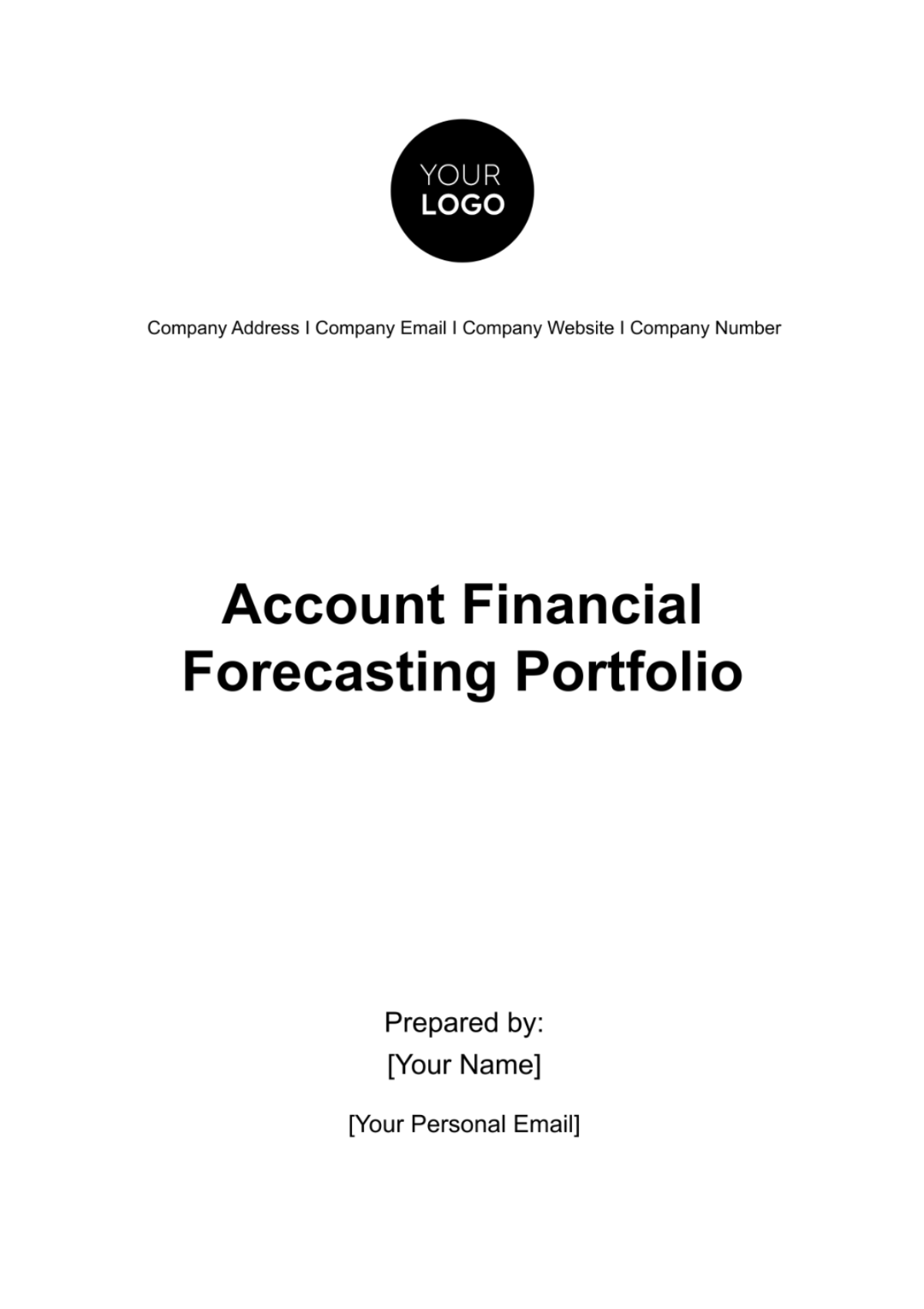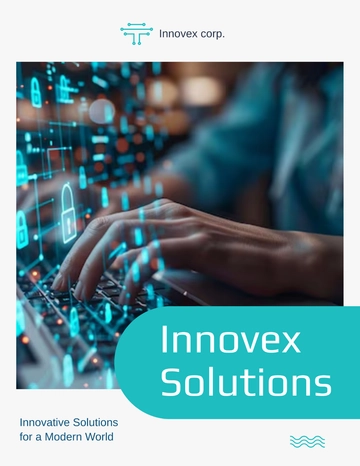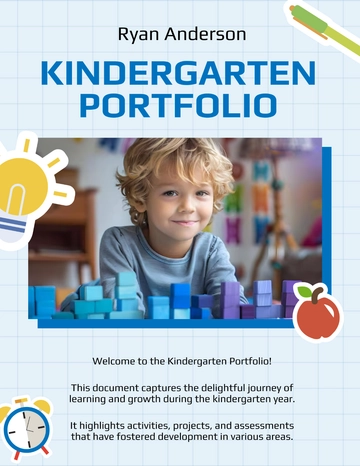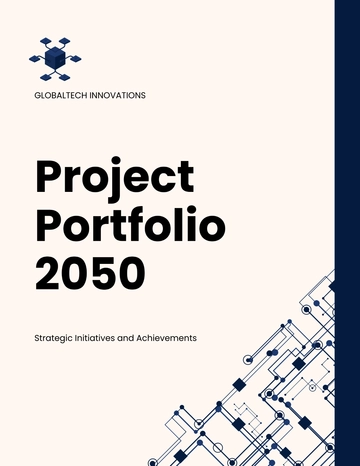Free Account Financial Forecasting Portfolio

Executive Summary
[Your Company Name] is delighted to present the Account Financial Forecasting Portfolio, offering a detailed outlook for the fiscal years 2050, 2051, and 2052. This report encapsulates [Your Company Name]'s financial performance, strategic investments, and key milestones, providing stakeholders with valuable insights.
A. Financial Performance Highlights
Projected Revenue Growth: [$50 million] - [12%] increase from the previous fiscal year
Net Profit Forecast: [$20 million] - [15%] growth compared to the previous fiscal year
Strategic Investments: [$15 million] Allocated for expansion and technological advancements
This report serves as a comprehensive guide for stakeholders and investors, enabling them to make informed decisions based on [Your Company Name]'s financial trajectory and strategic initiatives.
Introduction
The Account Financial Forecasting Portfolio for 2050 outlines [Your Company Name]'s financial strategy, aligning with our principles of transparency and strategic planning.
A. Business Objectives and Strategies
[Your Company Name]'s objectives for the fiscal years 2050, 2051, and 2052 include:
Expand Market Presence: Increase market share by [34]% through targeted marketing campaigns, entering new geographical regions, and engaging with diverse customer segments.
Enhance Operational Efficiency: Achieve a [24]% reduction in operating costs through streamlined processes, technological advancements, and optimized resource allocation.
Product Innovation: Launch innovative products, contributing [$65 million] to overall revenue. This initiative reflects [Your Company Name]'s commitment to staying at the forefront of industry trends.
B. Market Analysis
Industry Trends
The industry trends shaping [Your Company Name]'s strategy include:
Trend 1: Rising demand for AI solutions
Trend 2: Increasing importance of cybersecurity
Trend 3: Adoption of cloud computing technologies
Understanding and leveraging these trends will position [Your Company Name] for sustained success.
Competitive Positioning
[Your Company Name] currently holds a [43]% market share, establishing itself as a leader in software development. Competitive analysis indicates strengths in:
Key Strength 1: Agile development methodologies
Key Strength 2: Strong focus on customer satisfaction
Key Strength 3: Dedicated team of skilled professionals
Customer Segmentation
Identified customer segments include:
Segment 1: Startups: Small and medium-sized enterprises looking for scalable and cost-effective software solutions
Segment 2: Enterprises: Larger corporations seeking custom software tailored to their specific needs
Segment 3: Government Agencies: Public sector entities requiring secure and compliant software solutions
Tailoring products and marketing strategies to each segment's unique needs is integral to market penetration and revenue diversification.
C. Financial Strategy
Revenue Streams
Projected revenue streams for 2050 include:
Product Sales: | [$30 million] [60% of total revenue] |
Service Revenue: | [$20 million] [40% of total revenue] |
Continued focus on these revenue streams ensures a balanced and diversified income source for [Your Company Name].
Cost Management
Operational efficiency measures are anticipated to result in cost savings of [$10 million], leading to an improved EBITDA margin of [15%].
Investment in Technology
A significant portion of the budget is allocated to upgrading our technology infrastructure and tools, amounting to [$7 million]. This investment will enhance operational efficiency, scalability, and overall technological capabilities.
Business Overview
A. Industry Overview
Industry Trends
The technology industry is currently witnessing significant trends that directly impact [Your Company Name]' operations. Key trends include the rising demand for Artificial Intelligence (AI) solutions, the increasing importance of cybersecurity, and the adoption of cloud computing technologies.
Market Position
[Your Company Name] holds a 12% market share in the software development segment. Our competitive advantage stems from our agile development methodologies, a strong focus on customer satisfaction, and a dedicated team of skilled professionals. Continuous market analysis ensures our strategies align with evolving market dynamics.
Customer Segmentation
Our customer base is segmented into three primary categories:
Segment 1: Startups: Small and medium-sized enterprises looking for scalable and cost-effective software solutions.
Segment 2: Enterprises: Larger corporations seeking custom software tailored to their specific needs.
Segment 3: Government Agencies: Public sector entities requiring secure and compliant software solutions.
Understanding the unique needs and preferences of each segment allows [Your Company Name] to tailor its products and services, fostering stronger customer relationships and loyalty.
Financial Assumptions
A. Revenue Assumptions
Projected Revenue Growth
The projected revenue for 2050 is [$50 million], reflecting a [15%] increase from the previous fiscal year. This growth is based on a combination of market expansion initiatives, increased adoption of our AI products, and competitive pricing strategies.
Revenue Source Breakdown
The revenue sources are segmented as follows:
Product Sales: | $30 million (60% of total revenue) |
Service Revenue: | $20 million (40% of total revenue) |
B. Cost Assumptions
Operating Expenses
Operating expenses are anticipated to be [$7.5 million], representing [15%] of the projected revenue. This includes costs related to employee salaries, marketing, and administrative expenses.
Cost of Goods Sold (COGS)
Cost of Goods Sold (COGS) is estimated at [$12.5 million], accounting for [25%] of the projected revenue. This encompasses expenses associated with software development, maintenance, and client support.
Financial Projections
A. Income Statement
Year 2050 | Year 2051 | Year 2052 | |
|---|---|---|---|
Revenue | [$50 million] | [$55 million] | [$60 million] |
B. Balance Sheet
Year 2050 | Year 2051 | Year 2052 | |
|---|---|---|---|
Assets | [$80 million] | [$90 million] | [$100 million] |
C. Cash Flow Statement
Year 2050 | Year 2051 | Year 2052 | |
|---|---|---|---|
Operating Cash | [$12 million] | [$14 million] | [$16 million] |
Risk Analysis
A. Key Risks
Market Fluctuations: The industry is susceptible to economic downturns that may impact purchasing decisions. A comprehensive marketing strategy will be employed to mitigate this risk.
Regulatory Changes: Changes in regulations could affect operations. Regular compliance audits and legal consultations will be conducted to adapt to regulatory shifts.
B. Risk Mitigation Strategies
Diversification: Expanding product offerings and entering new markets to reduce reliance on a specific segment.
Compliance Measures: Proactive engagement with legal experts to stay informed about and comply with regulatory changes.
Investment Strategy
A. Capital Expenditure
In the fiscal year 2050, [Your Company Name] has strategically allocated funds to various categories to ensure sustainable growth and innovation.
Research and Development ($5 million): This substantial investment will fuel our commitment to innovation in artificial intelligence (AI) and software development. We aim to stay at the forefront of technological advancements, develop cutting-edge solutions, and maintain our competitive edge.
Marketing and Promotion ($3 million): A significant portion has been dedicated to strategic advertising and brand promotion. This includes targeted marketing campaigns, participation in industry events, and online and offline promotional activities to enhance brand visibility and attract a wider audience.
Infrastructure and Technology ($7 million): To support our ambitious growth plans, a considerable portion of the budget is allocated to upgrading our technology infrastructure and tools. This investment will enhance our operational efficiency, scalability, and overall technological capabilities.
B. Funding Sources
To secure the necessary funds for these strategic investments, [Your Company Name] will leverage a combination of equity financing and debt financing.
Equity Financing ($10 million): We will issue equity shares to external investors in exchange for $10 million. This approach allows us to bring in additional capital without incurring debt, while investors gain a stake in the company's success.
Debt Financing ($5 million): To diversify our funding sources, we will secure a $5 million secured loan. This loan will have an interest rate of 5%, payable over a period of 5 years. This method provides flexibility and ensures financial stability.
Key Performance Indicators (KPIs)
A. Financial KPIs
In the fiscal years 2050, 2051, and 2052, [Your Company Name] will closely monitor key financial performance indicators to gauge the success of our strategies and initiatives.
Return on Investment (ROI): We anticipate a robust ROI of 20% across the three years, reflecting the efficiency of our capital utilization and the profitability of our investments.
Earnings Before Interest, Taxes, Depreciation, and Amortization (EBITDA): Our estimated EBITDA is expected to grow steadily, reaching $18 million by the end of 2052. This metric is indicative of our operational profitability and efficiency.
Debt-to-Equity Ratio: With a targeted Debt-to-Equity Ratio of 0.5:1, [Your Company Name] aims to maintain a balanced capital structure, minimizing financial risk and optimizing shareholder equity.
B. Operational KPIs
Metric | Year 2050 | Year 2051 | Year 2052 |
|---|---|---|---|
Customer Acquisition | [150,000] | [175,000] | [200,000] |
Customer Acquisition: [Your Company Name] aims to acquire 150,000, 175,000, and 200,000 customers in the fiscal years 2050, 2051, and 2052, respectively. This growth signifies our expanding market presence and successful customer outreach initiatives.
Employee Productivity: We anticipate an increase in employee productivity, measured by revenue generated per employee. The targets are set at $250,000, $275,000, and $300,000 for the fiscal years 2050, 2051, and 2052, respectively.
Inventory Turnover: [Your Company Name] is focused on efficient inventory management, with targeted turnover ratios of 6, 7, and 8 for the fiscal years 2050, 2051, and 2052, respectively.
Conclusion
[Your Company Name] has meticulously crafted this Account Financial Forecasting Portfolio for the fiscal years 2050, 2051, and 2052. The presented financial projections, investment strategy, and key performance indicators embody our commitment to transparency, strategic planning, and sustainable growth.
As outlined in the document, our financial projections anticipate robust revenue growth, operational efficiency enhancements, and a commitment to innovation through strategic investments. The allocation of funds in Research and Development, Marketing, and Infrastructure reflects our dedication to staying ahead in the rapidly evolving technology landscape.
The investment strategy, supported by a combination of equity and debt financing, positions [Your Company Name] for financial stability and flexibility. Our adherence to a balanced Debt-to-Equity Ratio further underscores our commitment to prudent financial management.
- 100% Customizable, free editor
- Access 1 Million+ Templates, photo’s & graphics
- Download or share as a template
- Click and replace photos, graphics, text, backgrounds
- Resize, crop, AI write & more
- Access advanced editor
Experience financial foresight with the Account Financial Forecasting Portfolio Template from Template.net. This editable and customizable document empowers you to craft a comprehensive financial forecasting portfolio tailored to your needs. Utilize our Ai Editor Tool to effortlessly adapt and refine the content. Elevate your strategic financial planning, ensuring precision and adaptability in your forecasting endeavors. Unlock the power of accurate financial projections with this versatile template.





























